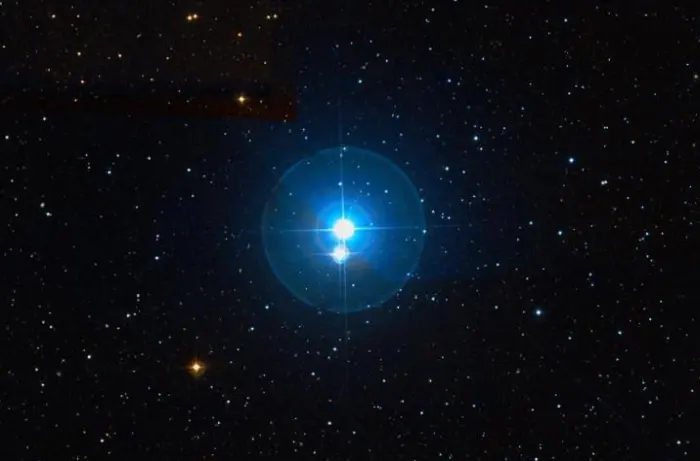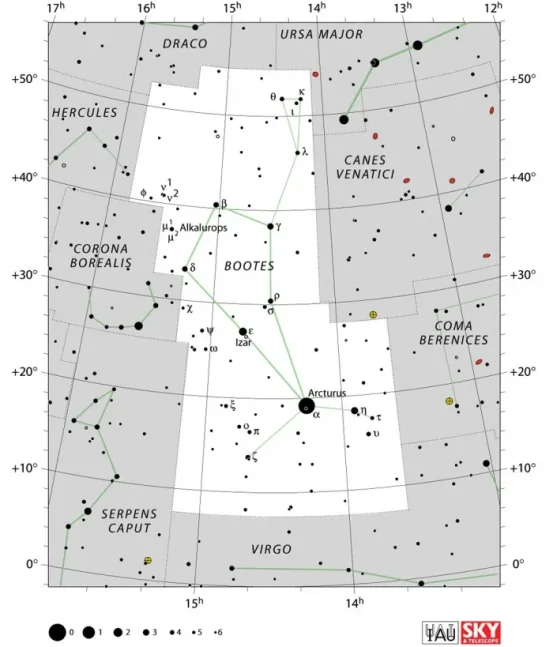Alkalurops, Mu Boötis (μ Boo), is a white subgiant star in a binary system located approximately 123 light-years away in the northern constellation Boötes (the Herdsman). With an apparent magnitude of 4.31, it is the 12th brightest star in the constellation. It appears in the northern part of Boötes, near the Kite asterism, a star pattern that dominates the Herdsman constellation.
Star system
Mu Boötis is a spectroscopic binary system composed of a yellow-white subgiant of the spectral type K2IV and a fainter companion. The two components are separated by only 0.10 arcseconds and have an orbital period of 3.75 years.
Alkalurops (Mu Boötis Aa), the primary component in the Mu Boötis system, has a mass of 1.6 solar masses and a radius 1.9 times that of the Sun. With an effective temperature of 7,000 kelvin, it is 20 times more luminous than the Sun. It spins at 80 km/s.
The companion, Mu Boötis Ab, has a mass 1.5 times that of the Sun. It spins at 40 km/s and has the same surface temperature as the primary star, 7,000 K.

Alkalurops (Mu Boötis), image credit: ESO/Digitized Sky Survey 2 (CC BY 4.0)
Facts
Alkalurops and its fainter companion form an optical double with Mu2 Boötis, a star system at a separation of 109 arcseconds. Mu1 and Mu2 Boötis appear in the same line of sight but do not have a common origin.
Mu2 Boötis is a double star with an apparent magnitude of 6.51, just below unaided eye visibility. The two components are separated by 2.30 seconds of arc. They have the spectral type G1V, indicating a yellow main sequence star. Individually, the components shine at magnitudes 7.2 and 7.8. They take about 260 years to complete an orbit around the common centre of mass. The stars are separated by 54 astronomical units.
Mu1 and Mu2 Boötis share a common proper motion and have similar parallaxes, which would normally indicate that they share a common origin. However, the components of Mu2 Boötis have a significantly different chemical composition from the Alkalurops system. The difference in the heavy-metal abundances indicates that the two binary systems are only experiencing a close encounter and did not form in the same molecular cloud at around the same time.
In early Arabic astronomy, Alkalurops formed an asterism called Al Dhi’bah, the Female Wolves (or Hyenas), with Nekkar (Beta Boötis), Seginus (Gamma Boötis ) and Delta Boötis. It is not to be mistaken for the Two Hyenas (or Two Wolves) asterism formed by Aldhibah (Zeta Draconis) and Athebyne (Eta Draconis) in the constellation Draco.
In fiction, Alkalurops was memorably used in Frank Herbert’s Dune novels. It was the host star of the planet Ix.
Name
The name Alkalurops (pronunciation: /ælkəˈljʊərɒps/) comes from the Greek καλαύροψ (kalaurops), meaning “the Herdsman’s staff” or “the Herdsman’s crook.”
The Greek astronomer Claudius Ptolemy called Mu Boötis κολλόροβον (“club”) in his Almagest in the 2nd century CE. The name was transliterated into Arabic as qulurubus and into Latin as calurus. During the Renaissance, the derivation of the Latin calurus was mistakenly associated with the Greek καλαῦροψ, meaning the “shepherd’s staff.” The Greek word was transliterated into Latin and then Arabicized with the definite article al– (“the”). Ultimately, the spelling was corrupted, and the name became Alkalurops.
The International Astronomical Union’s (IAU) Working Group on Star Names (WGSN) approved the name for the primary component of the Mu Boötis system on August 21, 2016.
Mu Boötis has been known by several other names throughout history. It was called Inkalunis and Incalurus in the Alfonsine Tables of 1521 and 1515. Its Latin names include Clava, meaning “the club,” and Venabulum, “a hunting spear.”
In old Chinese astronomy, Alkalurops was called 七公六 (Qī Gōng liù), the Sixth Star of the Seven Excellencies. It formed the Seven Excellencies asterism with 42 Herculis, Tau Herculis, Phi Herculis, Chi Herculis, Nu1 Boötis, and Delta Boötis. The asterism represented seven high ranked government officials. It was part of the larger Heavenly Market Enclosure, which represented the Emperor’s Realm.
Location
Alkalurops appears in the region of the Kite, a large asterism formed by the brightest stars of Boötes. The evolved star forms a triangle with the brighter Nekkar (Beta Boötis) and Princeps (Delta Boötis).
The Kite is formed by Arcturus, the brightest star in the northern celestial hemisphere, with the fainter Izar (Epsilon Boötis), Delta Boötis, Nekkar (Beta Boötis), Seginus (Gamma Boötis), Rho Boötis, Zeta Boötis, Muphrid (Eta Boötis), Tau and Upsilon Boötis. Arcturus can be found by following the imaginary curved line formed by Alioth, Mizar and Alkaid in the Big Dipper’s handle. The main body of the Kite appears between the Big Dipper and the constellation figure of Corona Borealis (the Northern Crown). The stars near the bright Arcturus form the Kite’s tether and tail.
At declination +37° 23’, Alkalurops is visible from locations north of the latitude 52° S.

The location of Alkalurops (Mu Boötis), image: Stellarium
Constellation
Alkalurops is located in the constellation of Boötes. The celestial Herdsman is one of the Greek constellations, catalogued by Ptolemy of Alexandria in his Almagest in the 2nd century CE. It stretches across 907 square degrees of the northern sky and is the 13th largest of the 88 constellations.
In Greek mythology, Boötes is associated with two different figures: the grape farmer Icarius and Philomenus, the son of the goddess Demeter. In Greek lore, Philomenus drove the oxen represented by the bright stars of the Plough (the Big Dipper).
Boötes is best-known for hosting Arcturus, the fourth brightest star in the sky (after Sirius, Canopus and Alpha Centauri). The evolved red giant star shines at magnitude -0.05 from a distance of 36.7 light years.
Other notable stars in Boötes include the binary stars Izar (Epsilon Boötis) and Seginus (Gamma Boötis), the yellow giant Nekkar (Beta Boötis), the orange giants Rho and Upsilon Boötis, and the white main sequence star Xuange (Lambda Boötis), a prototype for a class of metal-poor stars.
Deep sky objects in the constellation include the elliptical galaxy NGC 5886, the spiral galaxies NGC 5676 and NGC 5653, the unbarred lenticular galaxy NGC 5548, the Teacup Galaxy, and the globular cluster NGC 5466.

Boötes constellation map by IAU and Sky&Telescope magazine (Roger Sinnott & Rick Fienberg) (CC BY 3.0)
The best time of the year to observe the stars and deep sky objects in Boötes is during the month of June, when the constellation appears high above the horizon in the early evening.
The 10 brightest stars in Boötes are Arcturus (Alpha Boo, mag. -0.05), Izar (Epsilon Boo, mag. 2.37), Muphrid (Eta Boo, mag. 2.68), Seginus (Gamma Boo, mag. 3.03), Delta Boötis (mag. 3.482), Nekkar (Beta Boo, mag. 3.488), Rho Boötis (mag. 3.59), Zeta Boötis (mag. 3.78), Theta Boötis (mag. 4.02), and Upsilon Boötis (mag. 4.023).
Alkalurops – Mu Boötis
| Spectral class | F2IV |
| U-B colour index | +0.06 |
| B-V colour index | +0.31 |
| R-I colour index | 0.15 |
| Apparent magnitude | 4.31 |
| Absolute magnitude | 1.47 |
| Distance | 123 ± 4 light-years (38 ± 1 parsecs) |
| Parallax | 26.5759 ± 0.7871 mas |
| Radial velocity | −8.60 ± 0.3 km/s |
| Proper motion | RA: −149.928 ± 0.620 mas/yr |
| Dec.: +89.573 ± 0.789 mas/yr | |
| Constellation | Boötes |
| Right ascension | 15h 24m 29.4314684952s |
| Declination | +37° 22′ 37.761321648″ |
| Names and designations | Alkalurops, Clava, Icalurus, Inkalunis, Venabulum, Mu Boötis, Mu Boo, μ Boötis, μ Boo, 51 Boötis, 51 Boo, HD 137391, HR 5733, HIP 75411, SAO 64686, FK5 568, GJ 3903, BD+37°2636, AG+37 1409, GC 20724, GCRV 8919, PPM 78563, JP11 2601, NSV 7063, PLX 3483, SKY# 27889, CHR 181, ASCC 498542, GSC 02570-01521, GEN# +1.00137391, LSPM J1524+3722, N30 3470, SRS 30568, Renson 39052, ROT 2182, TD1 18226, TIC 233466081, PMC 90-93 402, IRAS 15225+3733, 2MASS J15242944+3722380, UBV 13255, UBV M 20764, USNO-B1.0 1273-00289313, uvby98 100137391, WEB 12864, TYC 2570-1521-1, Gaia DR2 1387349379494192896, Gaia DR3 1387349379494809600, STFA 28A, ADS 9626, CCDM 15245+3722, WDS J15245+3723A, WDS J15245+3723Aa,Ab |
Mu Boötis Aa
| Mass | 1.6 M☉ |
| Luminosity | 20 L☉ |
| Radius | 1.9 R☉ |
| Temperature | 7,000 K |
| Rotational velocity | 89 km/s |
| Surface gravity | 3.4 cgs |
Mu Boötis Ab
| Mass | 1.5 M☉ |
| Temperature | 7,000 K |
| Rotational velocity | 40 km/s |
| Surface gravity | 3.6 cgs |